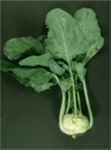 Early White
Vienna (55 days) Short tops and few leaves.
The bulbs are tender, creamy white and round. Good
raw or cooked.
Early White
Vienna (55 days) Short tops and few leaves.
The bulbs are tender, creamy white and round. Good
raw or cooked.
| HOME --> All Plants and Seeds INDEX --> Vegetables INDEX --> Kohlrabi | |
| Plant and Seed Mobile Friendly Index |
 Early White
Vienna (55 days) Short tops and few leaves.
The bulbs are tender, creamy white and round. Good
raw or cooked.
Early White
Vienna (55 days) Short tops and few leaves.
The bulbs are tender, creamy white and round. Good
raw or cooked.
| #636 Packet $3.50 Approximately 250 seeds |
|
Purple Vienna (60 days) Larger than White
Vienna, the bulbs are purple outside and greenish-white
inside.
| #637 Packet $3.50 Approximately 250 seeds |
|
CULTIVATION
Kohlrabi (also known as Turnip stemmed Cabbage) is a
member of the Mustard family, Brassicaceae (or Cruciferae),
and is related to mustard, broccoli, cauliflower,
kale, brussel
sprouts and cabbage.
Kohlrabi is unique in appearance with a large rounded stem
that resembles a turnip, with leaves developing on the surface of
the swollen stem. The swollen portion of the stem is cut
off, chopped and eaten like turnips.
Kohlrabi, unlike many members of its family, can be grown during
the summer months and is often used as a substitute for turnips.
Kohlrabi is easily cultivated and will grow in any well
drained soil rich in humus.
Kohlrabi is propagated by sowing seed. The seeds
may be direct sowed or seedlings can be grown
for transplants. For transplants, sow seed in pots
or trays using a fine sterile medium (1 part sand to 2 parts
sphagnum peat works very well). Sow seed and cover to a
depth of 1/4 inch. Keep moist at about 75F until seedlings
emerge, then lower the temperaure to about 70F daytime and 55
night time. When seedlings show their first true
leaves, transplant to flats or cold frames about 2-3 inches apart
each way. When the weather has settled in the spring and
nighttime temperatures stay above 55F, they may be planted
outdoors. Plant 8-12 inches apart in rows 18-24 inches
apart (The larger the mature head, the further apart the
plants should be.) Set the plants out and 'puddle'
(fill the planting hole with water) or water thoroughly after
planting. Cultivate regularly to keep weeds down and make
certain to water the plants during dry spells to prevent cracking
of the swollen stem. A dressing of humus or leaf mold
is beneficial (or an application of a 5-10-5 fertilize, at a rate
of 25lbs to 1000sq ft.)
To sow directly into the garden in full sun, wait until the
spring weather has settled and danger of a severe freeze has
passed. (see temperature graph below.) Work the soil
so that it is fine. Working in humus, peat
moss or leaf mold will give the plants a
boost. Sow 1 seed every 6 inches in shallow drills in rows
8-12 inches apart. Cover lightly to a depth of 1/4
inch. Keep the seeds moist until they sprout, then thin
seedlings to 18-24 inches apart. Water, cultivate and
fertilize as above.
HARVEST : Cut the swollen stems when
mature. Store on shelves at about 32F at 95% humidity.
A rich source of vitamins B6, C and K. It is also a source of
beneficial phytochemicals that may protect against stomach ulcer
and colon cancers.
SEEDING RATE: 100 seeds per 50ft
row; 79,000 to 112,000 seeds per acre st 2-3 seeds per foot
with rows 36 inches apart (depends on cultivar size)

There is great diversity in the kohlrabi varieties that
we offer; which makes the general information provided only
valuable as adjustable guidelines. This may also affect your seed
planting and propagation strategies and the germination
rates under your planting conditions may vary
from the seed lot test results. The following soil
temperature data is for kohlrabi in general. Temperatures
are average daytime from planting to emergence.
Percentage is average germination rate. Days is number of days to
emergence.
32ºF x 0% x 0 days; 41ºF x 27% x 27 days; 50ºF x
78% x 15 days; 59ºF x 93% x 9 days; 68ºF x 99% x 6 days;
77ºF x 99% x 5 days; 86ºF x 89% x 4 days; 95ºF x 0%
x 0 days;
ORDER EARLY!
See TERMS
Back to VARIETY INDEX
Terms HOME
![]() If you have
arrived in someone else's frame, or can not see all of the other
information available on richfarmgarden.com Click on logo to enter
from beginning
If you have
arrived in someone else's frame, or can not see all of the other
information available on richfarmgarden.com Click on logo to enter
from beginning